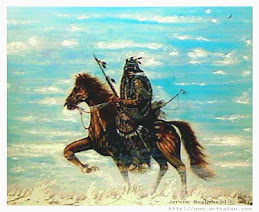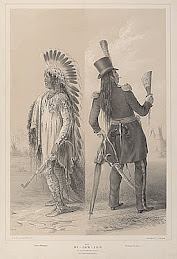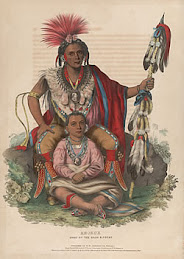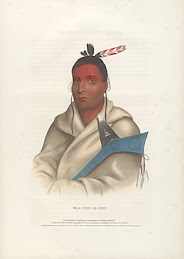



Enchanted Mesa, Florencita


Night Stories, Nocturne
My concept-folio topic is Native Americans and Native American art, focusing more on tribes in the United States region before, during, and after Europeans began settling in America.
 "Intensely brilliant colors and an almost mystical use of light bring a special joy to the canvases of Kevin Red Star. Kevin draws from his Crow culture for his subjects -- historical and modern. His exaggeration of the anatomical features and the haunting eyes captivate the viewer. Then the experienced hand finishes the canvas adding a deeper dimension. These are defining characteristics of the work of internationally acclaimed artist Kevin Red Star.
"Intensely brilliant colors and an almost mystical use of light bring a special joy to the canvases of Kevin Red Star. Kevin draws from his Crow culture for his subjects -- historical and modern. His exaggeration of the anatomical features and the haunting eyes captivate the viewer. Then the experienced hand finishes the canvas adding a deeper dimension. These are defining characteristics of the work of internationally acclaimed artist Kevin Red Star.Among the museums holding Kevin Red Star originals in their permanent collections are the Smithsonian Institution; Institute of American Indian Art in Santa Fe; Denver Art Museum; the Heard Museum in Phoenix; the Peirre Cardin Collection in Paris; the Eiteljorg Museum of American Indian and Western Art in Indianapolis; and museums in Belgium; China; Germany; and Japan, and most recently The Whitney Museum of Western Art in Cody, Wyoming.
Kevin was born on the Crow Indian Reservation in Lodge Grass, Montana-- the third oldest in a family of nine. His father had an abiding interest in music and his mother is a skilled craftswoman. In this nurturing environment, Kevin developed early artistic capability.
In 1962, Kevin's formal art education began at the Institute of American Indian Art (IAIA) when he was selected to be among the first 150 students for this experimental Native American art school in Santa Fe. Here Kevin was exposed to various mediums and expressions of art, learning the fundamentals of art from the finest Native American teachers. In 1974, Kevin was asked to return to IAIA to participate in their Artist-in-Residence program. While in Santa Fe, he expanded his art to include stone lithography, serigraphs and etchings.
In 1965, Kevin won a scholarship to the San Francisco Art Institute. As a freshman, he was awarded the Governor's Trophy, and Al and Helen Baker Award from the Scottsdale National Indian Arts Exhibition. Kevin continued studies at Montana State University in Bozeman and Eastern Montana College in Billings.
Kevin Red Star has emerged as the premier Northern Plains fine artist. Notable developments are even more exciting use of color and refined graphic design aspects in his latest work. As an art collector recently commented: He is among the Masters and will, during his life, enjoy his status as such.
The Crow Nation breaking away from the Hidatsa followed the buffalo herds to Yellowstone River Basin and eventually settled in the Bighorn Mountains and along the Tongue, Powder and Yellowstone rivers of Montana. Border for their present day reservation begins about ten miles southeast of Billings. Their name came from the white man's misinterpretation of the Hidatsa language name "Aapsaalooke" which means "children of the large beaked bird"--probably the raven. The Crow Nation is respected for their strong family ties, their artistic abilities, and their commitment to education -- a people of joy who share their culture with their children and others through events like the annual Crow Fair Pow-Wow and rodeo held every summer. From Red Star's heritage comes the subjects for his original oils. He does not consider himself a political painter. However, his ethnic ties are strong and he sees himself as a recorder of his Crow Nation's vanishing culture-- and as an artist working to satisfy his own creative expressions.
Therefore, you will see in Red Star's work the circle, symbolic of many aspects of Plains Indian culture: the camp pow-wow, the directional movement of the pipe during prayer, the design by which to live one's life, and the geometric beadwork and quillwork. The horse and warrior are often subjects for his work. The Native American woman rendered with great respect -- the woman's dress was a statement of her husband's prowess as a hunter of elk, only two teeth from each elk were taken for use as ornamentation on her dress. Red Star terms himself a romanticist. "The costuming of my subjects, for instance, is authentic, although at times exaggerated." When he became serious about his art, he studied and experimented with color and techniques of the Masters until his style evolved. One can always identify "Red Star" but his growth as an artist and person never stops, much to the delight of his collectors and fans. His philosophy parallels Robert Rauschenberg's: "There should be no barriers in art.""
 "Navajo artist Tony Abeyta has worked in many media to create paintings using sand, layers of oil paints, encaustic wax and collage elements that include earth pigments, bronze and copper as well as gold leafing. However, this summer Abeyta will work with yet another media – charcoal and ink washes – to produce a drawing installation for his new exhibition Underworlderness. Abeyta plans to “abstractly render the Navajo underworld, draw the realm we live in today and draw our relationship to the cosmos.”
"Navajo artist Tony Abeyta has worked in many media to create paintings using sand, layers of oil paints, encaustic wax and collage elements that include earth pigments, bronze and copper as well as gold leafing. However, this summer Abeyta will work with yet another media – charcoal and ink washes – to produce a drawing installation for his new exhibition Underworlderness. Abeyta plans to “abstractly render the Navajo underworld, draw the realm we live in today and draw our relationship to the cosmos.”The exhibition will also differ from his usual work in that Abeyta will draw and paint directly on the gallery wall to render the large – as large as 10 feet high – work of art. While he is painting, Abeyta’s 17-year-old son Gabriel will document his work on video and then create a short film utilizing reverse time-lapsed footage to reduce as much as four to six hours of painting to three minutes of video. Gabriel Abeyta will also incorporate original music into the video. Once completed, the video will be shown on several monitors in the gallery.
Tony Abeyta has studied painting extensively, attending Santa Fe’s Institute of American Indian Art, Maryland Institute’s College of Art in Baltimore, the School of the Art Institute of Chicago (for which he received a Ford Foundation Scholarship) and New York University. Most recently, Abeyta’s work was influenced by his travels to Europe, where he spent considerable time in Florence, Italy. While in Europe, he had the opportunity to see and study paintings by masters including large-scale works such as Pablo Picasso’s “Guernica."
In his early paintings, Abeyta used brilliant colors to depict magical journeys into Diné culture and Native spirituality. By 2002, his palette had changed to more subtle and somber earth tones. His black-and-white charcoal and ink drawings featured in Underworlderness are yet another provocative exploration by this creative artist. In the drawings and the mural, Abeyta will explore themes of plant life – seeds emerging from the ground – and abstractions of animals.""
Silko, Leslie Marmon. Ceremony. New York: Penguin Group, 1977.
p. 122
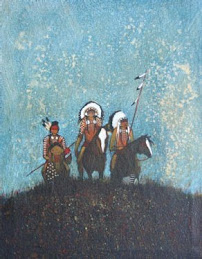
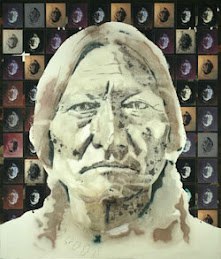
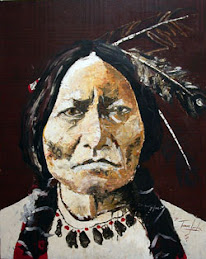
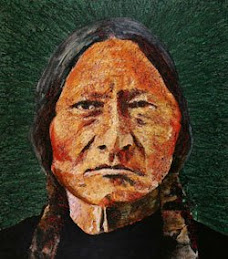

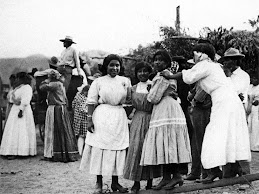
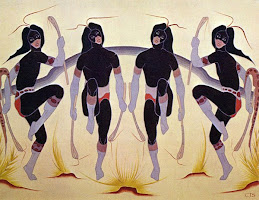




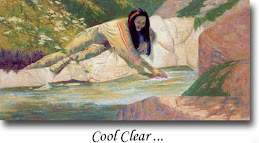

,+Peggy+O%27Neal.jpg)
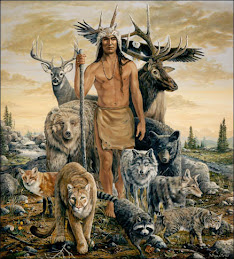,+Peggy+O%27Neal.jpg)
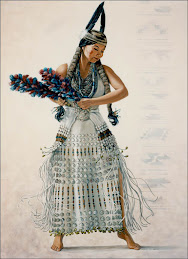,+Peggy+O%27Neal.jpg)
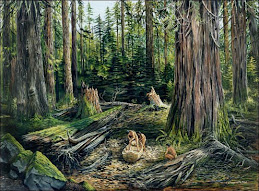,+Peggy+O%27Neal.jpg)
